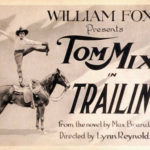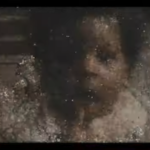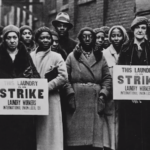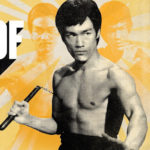SPEAKING IN PALINDROMES
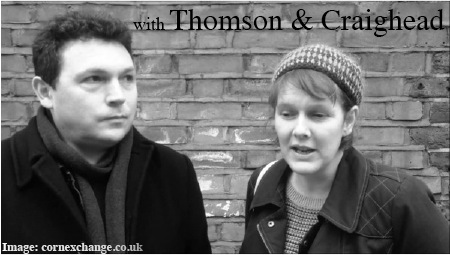 an interview by Caylin Smith
an interview by Caylin Smith
n
Jon Thomson and Alison Craighead — Thomson & Craighead — use data and video that they have discovered online to create artworks that actively reflect upon life in the Digital Age. By repurposing material found online, including websites from such platforms as YouTube and Twitter, Thomson & Craighead prompt their viewers to question how content from different sources can be placed in conversation with each other and how this reveals and influences how we communicate and juxtapose information.
MIAN contributing writer Caylin Smith spoke with them about finding inspiration for their artworks, providing access onsite and online, engaging with audiences and web users, and how are they handling the tricky business of preserving “born digital” audio-visual art works. This interview took place during Thomson & Craighead’s summer 2013 exhibition Never Odd or Even at Carroll Fletcher, but pertains to their work more broadly.
Caylin Smith: Could you begin by talking about your artistic backgrounds?
Alison Craighead: We met in college and we both studied drawing and painting, but early on we wanted to work with video and moving image.
Jon Thomson: I was doing a post-grad [in electronic imaging] and Alison was doing a degree in drawing and painting, and because we were both working with moving image — this was in the early ’90s and so the video hardware was quite big and bulky — everyone tended to work in teams in order to get stuff done. That’s where we met and started working on each other’s projects, but we didn’t collaborate initially. That came later…
How did you come to switch mediums and start experimenting with the Internet and the artistic possibilities it provides?
JT: Around ’92-’93, the first web browsers started to pop up and then non-linear editing systems emerged and became more accessible at that time as well. And those non-linear editing systems became standard pieces of software and computers became online over the course of the ’90s and up to the turn of the millennium. But it certainly wasn’t a consistent thing as it is these days. As computers became connected, we became aware of the Web and it seemed a naturally interesting place to go to because of what it represented in terms of being a hypertextual landscape. To begin with, it was just text and images.
It was happenstance and our age because we both graduated from art school in ’92 and ’93. The World Wide Web was really just appearing in earnest at that time, and so we were aware of that zeitgeist as well: we are the last generation before the Internet and so we felt its arrival very keenly.
Does that play a part in your work since you have seen how the Internet has evolved as technology has developed?
AC: It is part of our experience of it [the Internet]. Data is our material so we just have a [working] knowledge of it now, because we’ve been working with it for a while. We just recognise things that interest us.
JT: The first time we started working in a networked environment was around ’95. There’s a natural evolution because technology steps up as time passes, and so there’s a natural historicisation of our works because of what we have made at different times.
That leads into my next question of how the Internet is a vast repository of information and material and information that can be repurposed for artistic uses. What is your approach to finding content or inspiration when you want to begin a new project?

Thomson & Craighead, Tallinn Wall. Image by Rasmus Jurkatam, courtesy/© gateways
AC: Personally, I’m quite voyeuristic. I really like looking at things and I’m quite nosy, so I’m the kind of person who hangs about. Sometimes it can feel a bit aimless because you just look and you browse different parts of the Internet where you may not have been, and you think about what’s happening. And after browsing, we’ll have conversations about what I have found or what’s missing; it’s quite a strange thing. We spend quite a lot of time logging things that we find and it’s a slow process.
JT: Our practice as artists is quite varied in that sometimes we’re making work in the studio, while other times we are commissioned, or someone asks us to make something for a specific context. When you’re working in ways that respond to different situations, you start thinking about what kind of work you can make within that context and you react against it, whereas most of the rest of the time, we are working more aimlessly in a studio-based way.
Over the last 10 years, there has been a progression in our work where we’ve been looking quite closely at how live information can be used as a material to make works out of, so that doesn’t necessarily have to be online. It just happens to be that lots of live information comes to us via the Internet.
We also look anthropologically or socially at the web and at the ways it changes how we all behave. That is when we might use social media or look at YouTube or how we all take photographs and share them in communities like Flickr.
After you’ve made a few works, you look back on them and that creates a context and precedent in and of itself and suggests new directions that you might want to go in.
Could you explain how you see your own projects fitting into present-day socio-political issues and how these issues are documented and disseminated?
AC: Today I was thinking a little bit about this work we made about the Occupy movement, so maybe that’s quite interesting to think about here? It was something we did for Brighton Photo Biennale in October 2012.
They wanted us specifically to think about the Occupy movement and Jon and I became quite interested in how quickly the movement had spread across over nine hundred different cities. There was Occupy in China, there was Occupy in South Africa, as well as the very well known sites like New York and London — we were interested in tracing the movement and how quickly it spread within that two-month period: it would not have existed and behaved the way it did if there hadn’t been the Internet. We were interested in how you can witness a global movement or document a global movement through the Internet or through YouTube. This is how they disseminated information. This is how they gathered together. And this is how they thought collectively.
JT: It is perhaps the most obviously political work we’ve made. As Alison says, our interest was twofold: we wanted to make a portrait of the movement as it was at the end of 2011 because it was remarkable what happened—the fact that it propagated itself across the world in the course of a week. And then a month or so later, a lot of the camps were closed down in a fairly comprehensive fashion as well. Those moments at the beginning of the Occupy movement seemed like something we wanted to fix or make into a portrait.
At the same time, we wanted to try and understand how the Web and Internet had informed the way in which the protests actually happened, but also whether and how you can actually apprehend a global explosion of a movement in the first place. This was particularly since most of the mainstream media, when it actually reported about the Occupy movement, would tend to go, “Yes, we have Occupy here” — in wherever they were reporting from — “and of course it’s everywhere around the world, too.” But there was no one that looked at it as an equivalent phenomena that had spontaneously propagated in that way, so it’s experimental in a way for us to use the Web and social media as a way of seeing and apprehending this movement. And of course you can’t in lots of ways, but of course you can in lots of ways as well. It’s a distorted kind of view, just as any view is distorted, I suppose.
It must have been such a big undertaking to sift through material, especially since Occupy was such a global presence where cells could be found all over the world.
JT: It was pretty full on. We spent five to six months looking at material and it was quite painful.
AC: It was very painful, but the Internet is also an incredible resource. Wikipedia is really comprehensive in terms of documenting the camps and arrests. It was quite an interesting place to witness a movement or try and see something through. And we’re really interested in how we can perceive the world through the network as well and what we can understand from it.
Did you end up visiting any of the Occupy camps that were set up?
JT: The only one being London.
OK that’s what I was wondering or whether you limited your experience of Occupy to being mediated through the Web.
JT: For the purposes of the work, we did restrict ourselves consciously in that way. From a slightly more personal standpoint, the Occupy movement came close on the back of a lot of student protests in 2011, following the introduction of [greatly increased] fees. And because we both teach at art school, we were both connected and involved with some of the student movements, especially at UCL where I’m at the Slade, because they were quite active in protesting. And that kind of segued seamlessly into the Occupy movement. For the purposes of the work, it was relevant only because it was connected and part of our own experience: it wasn’t relevant for the formation of the work and what we were interested in examining.
Can the decision to distribute your works online be read as a preservation effort or initiative? And then, how do you view the longevity in terms of your artistic process? Is this something that comes into mind when you’re creating a work?
AC: Since we take stuff from the Web, we think it would be really ungenerous not to share our work back on the web. It’s just a basic principle.
JT: October, which is the documentary artwork we made about Occupy, just went online recently. The work was shown as a gallery installation in October 2012 through until Christmas as part of the Biennale, and it has actually taken us until the end of May to get an online version of it made. This was partly because we were trying to think of a simple way that we could engender what happens in the installation because it’s a two screen installation and it uses a compass like in Belief.
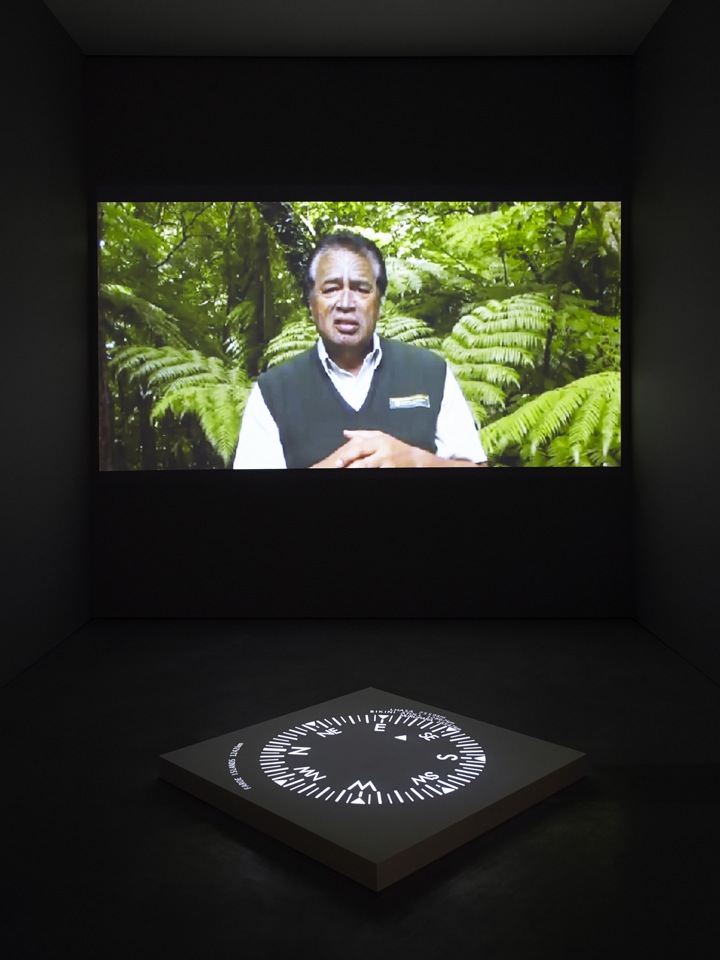
Image: Carroll / Fletcher
October uses exactly the same idea of putting you in the centre of a data visualisation using this compass but the compass couldn’t be put online streaming unless we tried to sample the IP address of the visitor and that’s not really reliable. It was hard to make the compass behave in a way that would be relevant for each person accessing the work online, so we ended up putting GPS info for each clip at the bottom, and it took us a while to get there in terms of making something visually simple. We’re glad that it’s online because, as Alison was saying, it seems a bit mean of us if we cull this stuff and don’t send it back into the network.
AC: And in terms of our practice, we try to be as generous as possible, especially with something like A Short Film About War, where so many people allowed us to use their photographs through Flickr. It’s really important that they have an opportunity to see the work and for the other people to experience it. Obviously, it’s a different resolution and size, and for us, to see the work properly installed is our favourite thing–that’s the proper work–but we do think it’s important that we also allow something to be disseminated online so as many people can see the work as possible.
JT: Because we think about using live information as a material—especially when you are making works that are live–it makes a big difference when they’re actually in the gallery, because you do have that slight critical distance where you perceive the liveness of it as part of the material presence of the work. Whereas if you’re online and it’s a live work, it’s a bit different and perhaps less pronounced. The ideal context is that vacuum of the gallery or some sort of specific site that’s physical, but you were also asking about preserving works more generally?
Yes, you have created your own online archive through posting video versions of the works, which can be viewed as a preservation effort despite the fact that they don’t completely capture the experience of viewing the works in galleries.
JT: Yes we do, but especially with live works, it’s difficult to think how they can persist and in some cases they are a bit like performances: you make something, it has a lifespan, the browser becomes out of date or the information becomes obsolete, and the work dies.
At the same time, we do make works where we might simulate it [in its live form]. There’s a piece we made called Horizon, which has webcams from every time zone in the world, and it still functions as a live work, but it changes because when cameras go down we have to replace them and so on. But we have, at various points, taken twenty-four hour simulated snap shots of the work, so it can exist in perpetuity as a simulation rather than a recording. Other works are much more straightforward or course, like A Short Film About War, which is simply a two channel video installation.
AC: Each work needs to be archived and thought about differently.
JT: It’s done on a case-by-case basis, and I think museums still have a long way to go in terms of dealing with IT because you tend to have departments that might do the website or something else, but it has yet to come into the mainstay of the curatorial remit of the institution. It’s a bit like photography in earlier days: just as there are people who restore minimal concrete sculptures or keep them in good condition, there should also be people who are capable of perpetuating works that use the Internet or use software or exist in the digital realm. There’s a simple shift in culture that hasn’t taken place yet [in the museum]
One of the other things I find interesting about your projects is how they actively question conceptions of space and time and also how they each have their own visual language. One of my favourite examples is BEACON because the work can be viewed as expanding from one’s personal space in front of the computer, to the more public and group setting of the gallery, and then to the outdoors with the flip letter sign where it’s displayed for a public that might not have seen your work otherwise. I was wondering if you could talk about these relationships and an artwork that exists in different iterations.
Image: Carroll / Fletcher
JT: BEACON is a good example because it exists in three forms. It’s online as a URL called automatedbeacon.net, and that looks and feels like an amateur radio repeater, and we quite like the fact that it’s something that people might encounter as an artwork or might encounter as a place, as a URL, as a thing that can be seen on its own terms. Then there’s a projected version that goes into the gallery and displays the text on the wall and is projected at the same speed as the Web version. And finally there’s the railway sign, which is a bit slower — it’s every sixty seconds — and obviously more monumental and monolithic and using a predecessor technology [the railway flap sign] as a way of displaying live information.
And it’s quite a good example of a work that has changed over time in terms of its back end in order to accommodate the shifts and changes technologically. It displays a random search that’s being made at that moment online, but also we’ve had to change that software as websites have become slightly more closed and some of that information has become less available. We now have it in a state where it’s able to find live searches from a couple of places, but if it can’t get them at that time, it pulls from a database of a million searches. That database of a million will end up being the work in perpetuity and so the work will shift and become over time, not about the live moment, but more about a particular moment in the past. Perhaps, it will be a [useful] record of online culture at that time assuming that it exists in the long term.
AC: I think by doing this, we are taking that step to say that this will exist in the long term because I think as a hack it’s been going since 2004.
JT: Which is amazing and far longer than we thought it would last.
AC: It’s been an incredibly reliable hack, but we have to think long term; everything changes all the time. There are points where security on search engines gets tighter and they find our bit and cut us out. It’s a gardening problem.
Did the flap sign version that was shown at Carroll / Fletcher contain new searches as well?
AC: Yes, we wrote a program where we have two hacks into search engines that are live, but sometimes they get turned down, so we have a script saying ‘go here to this address, pick one up, and choose out of the twelve’, and then if that address isn’t working, it goes to another search engine and ask for one, and it doesn’t return then you pull from the database. It has two attempts at live and then the third attempt it goes to the archive. We see it a little bit like Wimbledon: we spent a lot of money getting a roof put on, so we can still have tennis when it rains.
Otherwise, it would just get too embarrassing. If Google or the search engine did some backend work and we got blocked and you had to show up to a museum because they had called you, saying that it had gone blank. You would have to apologise for a search engine that you had illegally hacked.
When you install a work in a gallery of elsewhere, do you work closely with the conservator or whomever else and explain to them what should happen if a problem arises?
JT: Yes and it varies. It depends on what the organisation is like that you’re working with and sometimes that experience can be extremely good and sometimes it can be a bit difficult. An example of a very good experience is where everything is put in place and everyone knows what to do if something goes wrong. Or especially these days we try to get the computers that might be running works sent out to us well in advance so we can turn up with the computer fully prepared. That saves a lot of time! But sometimes those institutions just aren’t prepared to send the kit out in advance, and I think that’s the single thing that makes a big difference in terms of presenting our work currently. If we get the computers beforehand, there are many less problems when we actually install. As for contingency, that depends on the curators and invigilators.
When we first began making work like this, the work was not familiar to anyone in terms of its processes because it was quite early on. But these days, people understand what’s going on and are a lot more on board and used to dealing with what it is that we’re working with.
Back to the process of putting your works online or displaying them in a new setting: do you see this as an attempt to potentially gain new audiences as well?
AC: Yes. When people have asked to come and work with us, it’s interesting to find out how they know about our work. Sometimes it will be like “I found your website in 2000”—it might have been a while ago, but they liked something we did then and remembered us later. It is nice to think about having different audiences because not everyone can get into galleries and not everyone has access to museums. It’s a very difficult audience to engage with because you don’t know who they are and what their understanding was of a work. It’s a very different engagement.
JT: People will contact us through the website and sometimes that’s requests for works for exhibitions and sometimes students asking questions for a thesis. Occasionally, people just ask stuff because they want to know or perhaps they have a question about a particular work, and that’s quite nice when it happens. It happens regularly not frequently: it would be a nightmare if there were loads every day. But people do get in touch and in terms of the hard numbers, more people encounter our work through our website than they do through galleries and museums. As Alison says though, if you believe the numbers then it’s more, but that’s lots of people who might spend a minute on your website or may have come to you when they were looking for something else, and so it can be misrepresentative.
AC: I think that’s true of all the statistics you pull down from your server —I never trust the statistics.
JT: It’s a lot better than it used to be. When we first put our website up, it would just count Web hits—hits against your server—so in the early days people would be going, “Wow! Thirty thousand people are coming to my site every twelve days.” It’s a lot better these days because it filters that noise out, but nevertheless it’s a strange game.
But it can be the same, too, for the gallery where you have someone there in person, but they might spend only a few seconds in front of an artwork.
AC: Absolutely.
JT: Absolutely.
It is hard to gauge interest.
AC: It’s a very strange thing, isn’t it? You have no idea why they have come. They could have come specifically to see it or they could have been walking past and thought, “Why not?” It could just be either time filling because they want to go somewhere else and it’s about to rain. Audiences are really interesting in terms of where they come from.
JT: And so we really value it when we do get feedback.
I attended a conference on born digital art back in December 2012 and a really interesting observation came up in regards to Beacon, but I think it can also apply to London Wall and Tallinn Wall and those projects, regarding how you get a visual of the person who is conducting these searches or writing tweets. Could you expand on the idea or the role that narrative plays in your projects?
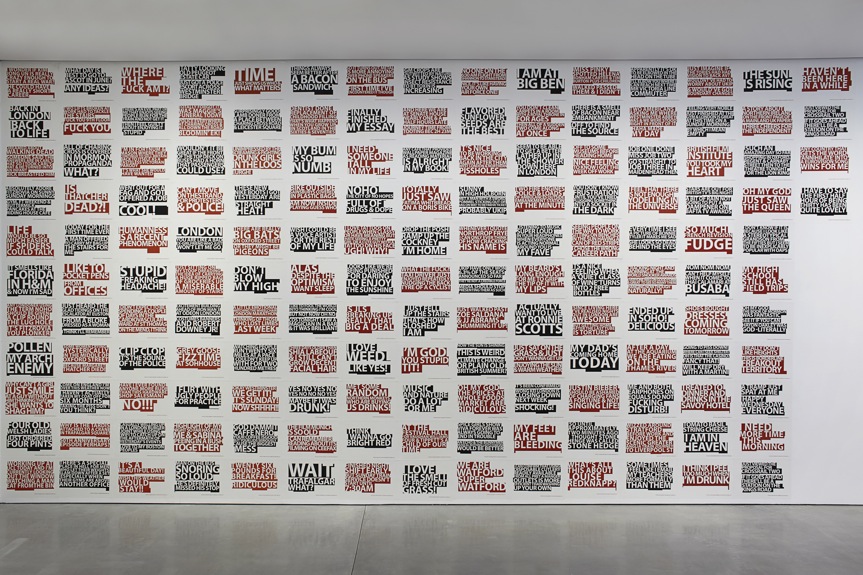
Image: Carroll / Fletcher
JT: I think in the case of BEACON it’s an interesting one because what you’re seeing is something that’s often quite intimate but completely anonymous, and so you have a strange view of that kind of information. We think of the London Walls as poems or a form of concrete poetry that we performatively make appear in the museum, but it’s not anonymous. Twitter is a broadcast medium and we credit the uploader or user who wrote the tweet on the poster. Although it’s in small lettering at the bottom of each print or poster, it is a level of information that’s available to you. I think you’re more aware of the different voices of the crowd. Whereas something like BEACON is a more seamless broadcast where your relationship with the unseen users is slightly different.
We are interested in how narrative forms in the network and how taking just a geographical coordinate of an area and making these poster walls, you end up getting a landscape or portrait of a certain vicinity and also of a certain time and how that has narrative potential. With the design of the poster, we tried to follow the rhythm of the tweets, so a word that’s stressed will be bigger or the breakdown of each phrase is separated by gaps, so that visually what you have is the loudest words, the shouted words, at a distance, and as you walk towards the wall and away from if you get different levels of detail. And that’s quite important to us.
There’s a story by Italo Calvino called The Castle of Cross Destinies that is all about people trying to tell stories about each other’s lives using a tarot deck of cards, and it’s a modernist fairy tale, where people find that they suddenly can’t speak so they communicate through using these decks of cards. In weird sort of way, although it’s lots and lots of different people saying individual and sometimes banal things in the London Wall, we are quite interested in those un-thought of intersections and what they might present or represent in terms of narrative potential. We don’t want to be prescriptive. We want it to exist almost like a shape or a form.
Have you ever had someone contact you and say, “I don’t know how I feel about you using my video or my tweet in your works”?
JT: I’m not sure if we have.
AC: That’s quite interesting. I have found things and I’ve recognised the person in them and not wanted to use this material because I felt very strange. In 1997, I remember we did a work with a radio scanner where you could scan [listen in to] people’s telephone calls.
JT: This was before the network went digital, so you could pick up people’s phone calls within an area
AC: I was on the scanner and we were recording conversations for a work called Speaking in Tongues and I recognised a person on the phone, and that really freaked me out. It was also an intimate phone call –somebody in trouble trying to get to the hospital, and I knew them. It put us in a strange situation about why we even knew this had happened. It was a strange moment.
But in the case of using people’s videos, we generally ask, and if someone has an objection we wouldn’t include it in the work. We’ve only been turned down once.
JT: That was when we were making A Short Film About War, and the person who put the photograph online was an artist and they said they didn’t want us to use it. But in the case of A Short Film About War, we restricted ourselves rigorously to creative commons material, so material that you’re allowed to use if you attribute the person who originally uploaded it, which we do in the credits of the movie. You can then use the material without asking them, although we did actually ask everyone as well. And so we ended up with this participant audience made up of scores of people, and we first made the work available to them so they could look at it online. It’s an interesting different kind of audience, where they’ve contributed something to it. We found people photographers generally were very generous and happy for us to use an image.
With YouTube, it’s a bit more ambivalent and we’re not sure whether it’s just a slightly different demographic, but people just don’t seem to care. We ask people about whether we can use their material, and they just don’t respond. If they do respond, it’s a “yeah” or “whatever” and so it’s a bit different [to the photosharing communities like Flickr]. I think people are more conscious of it being a disposable broadcast. Twitter’s a broadcast context again, so it’s pubic in a way. YouTube isn’t public because it has a really weird contract when you upload video. They say that you still own the video, but we at YouTube can use it for anything forever in anyway we want and at any time, and so you give away all your rights on YouTube without actually giving away the material!
AC: It’s very strange, isn’t it? In the end I think you need to approach each community differently. With Twitter, you might just fire off a tweet, whereas if you upload a video to YouTube, it might be something that you worked hard to produce. There’s a different time investment involved.
JT: It’s true, but it is interesting how our experience of YouTube has been overwhelmingly that people don’t care.
AC: Well we don’t know that they don’t care, they just don’t ever respond to us. If you look at Several Interruptions, I think the Swedish or Norwegian diving team member named Lars was one of the only people out of the swimming pool people who responded. And he was really lovely and happy to be part of the work. Personally, I was a little bit surprised because I would…I’m a prude. I’m British. So I wouldn’t put a picture of myself in a swimming costume online. [Laughter] So I thought people would be more protective of their image or their family’s images as well because it would be shots of families in swimming pools.
Thomson & Craighead’s exhibition Never Odd or Even was held at Carroll / Fletcher in London from 24 May to 6 July 2013, and was extended until 13 July 2013 due to its popularity. Their exhibition Not Even the Sky was recently at MEMO Kunsthalle in Memmingen, Germany. A further solo exhibition of their work, Maps DNA and spam, will be held at Dundee Contemporary Arts from 18 January 2014
Previous Post: "The Daughter of Dawn" Will Never Go Dark
Next Post: "Men and Dust": Breath That Kills

